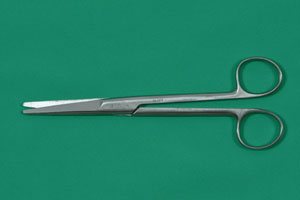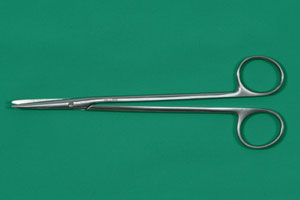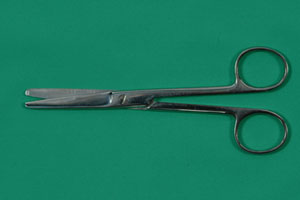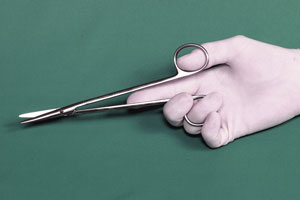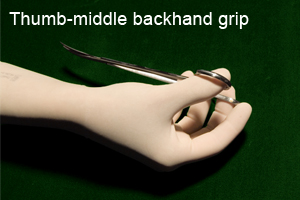Overview
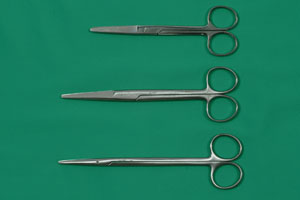
- a common surgical tool for cutting or dissecting tissues.
- used to cut loose tissues, the blades stabilize the tissues during cutting
- provides very good control of depth and direction of cutting.
- more traumatic than scalpel because they crush during cutting.
Goal
- contolled use of tissue scissors during scissor cutting, push cutting and blunt dissection
Skills to Practice
- wide-based tripod grip
- accurate scissor cutting
- controlled push cutting
- accurate, efficient blunt dissection
Basics
- scissors are classified according to
- tips (sharp-sharp, blunt-blunt, sharp-blunt)
- blade shape (straight or curved)
- cutting edge (normal or serrated)
- blunt-blunt tips with a normal cutting edge are typically used
- straight scissors provide more mechanical advantage for cutting thick or tough tissue
- curved scissors allow greater maneuverability and visibility
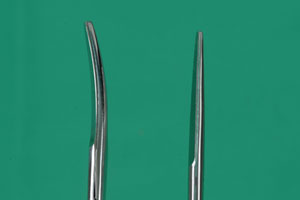
- scissors come in a variety of sizes and designs depending on their intended use
- commonly used basic types include:
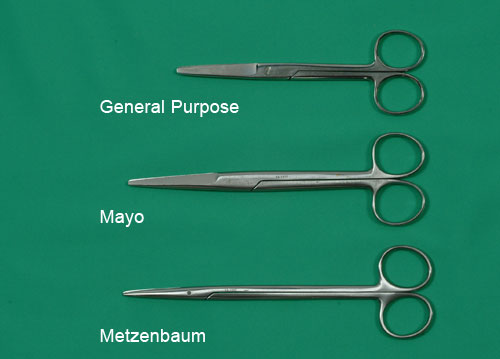
Mayo scissors
- sturdy design
- used to cut heavier tissues (eg. linea alba, thick fascia)
- [ memory tip: “short” name” → “short” handle]
Metzenbaum scissors
-
- relatively finer design
- used for fine tissues and blunt dissection (eg. subcutaneous and light fascia)
- [ memory tip: “long” name” → “long” handle]
General purpose ("suture") scissors
- relatively shorter and broader blades
- commonly lower quality (cheaper) so can be frequently replaced as become dull or damaged
- used to cut sutures and other materials, NOT tissues
- preserves the sharpness of the tissue scissors
Holds
Wide based tripod grip
- most efficient hold
- thumb and ring finger through the rings
- middle finger is placed on top of the finger ring
- index finger is placed along handles towards fulcrum (improves control of tips)
- avoid putting fingers too far into rings as limits maneuverability and comfort (stay above first knuckle)
- avoid putting index or middle finger though ring as decreases stability and efficiency
- left-handed surgeons: most adapt to using scissors with right hand but left handed scissors are available
Backhand grip
- typically used for cutting from left to right (less awkward)
- thumb and middle finger through the rings with handle resting on third and fourth fingers
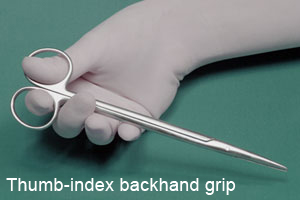
- can be modified when cutting fowards body
- thumb and index finger through the rings
- more comfortable efficient and controlled
How to Use
Scissor cutting
- more traumatic than scalpel but gives excellent control
Technique:
- blades partially closed over tissue and elevated slightly (stabilizes tissues)
- tips closed to cut the tissue
- only use the tips
- more crushing trauma and jagged edges if entire blade used
When continuing an incision
- tips are not closed completely
- blades are re-opened, tips advanced and more tissue cut
- continues for entire incision length
- avoids creating a series of jagged cut
Push cutting
- efficient cutting method
- used for longer incisions in light fascia
Technique:
- begins with a scissor blades partially closed (tip still open)
- continue by pushing the nearly closed blade forward through the tissue
- tissue is cut in one continuous motion without further opening/closing of the blades
- scissors should advance easily without tearing the tissue or technique is abandoned
Blunt dissection
-
used to separate fine tissue attachments between anatomic tissue planes and isolate delicate structures
- nice for separating muscles, fat and fine fascial planes
- more traumatic than sharp dissection (scalpel or scissor)
- creates more dead space
- not for dividing strong fascial attachments
Technique
- closed tips of the scissors are inserted into tissue
- blades are opened separating (tearing) loose tissue connections
- scissors tips are removed without closing the blades to prevent uncontrolled cutting
- the process is repeated as needed
Blunt dissection


